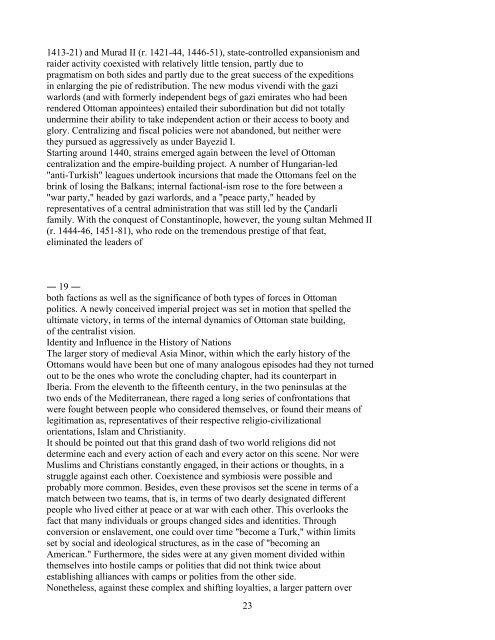Between Two Worlds Kafadar.pdf
Between Two Worlds Kafadar.pdf
Between Two Worlds Kafadar.pdf
You also want an ePaper? Increase the reach of your titles
YUMPU automatically turns print PDFs into web optimized ePapers that Google loves.
1413-21) and Murad II (r. 1421-44, 1446-51), state-controlled expansionism and<br />
raider activity coexisted with relatively little tension, partly due to<br />
pragmatism on both sides and partly due to the great success of the expeditions<br />
in enlarging the pie of redistribution. The new modus vivendi with the gazi<br />
warlords (and with formerly independent begs of gazi emirates who had been<br />
rendered Ottoman appointees) entailed their subordination but did not totally<br />
undermine their ability to take independent action or their access to booty and<br />
glory. Centralizing and fiscal policies were not abandoned, but neither were<br />
they pursued as aggressively as under Bayezid I.<br />
Starting around 1440, strains emerged again between the level of Ottoman<br />
centralization and the empire-building project. A number of Hungarian-led<br />
"anti-Turkish" leagues undertook incursions that made the Ottomans feel on the<br />
brink of losing the Balkans; internal factional-ism rose to the fore between a<br />
"war party," headed by gazi warlords, and a "peace party," headed by<br />
representatives of a central administration that was still led by the Çandarli<br />
family. With the conquest of Constantinople, however, the young sultan Mehmed II<br />
(r. 1444-46, 1451-81), who rode on the tremendous prestige of that feat,<br />
eliminated the leaders of<br />
― 19 ―<br />
both factions as well as the significance of both types of forces in Ottoman<br />
politics. A newly conceived imperial project was set in motion that spelled the<br />
ultimate victory, in terms of the internal dynamics of Ottoman state building,<br />
of the centralist vision.<br />
Identity and Influence in the History of Nations<br />
The larger story of medieval Asia Minor, within which the early history of the<br />
Ottomans would have been but one of many analogous episodes had they not turned<br />
out to be the ones who wrote the concluding chapter, had its counterpart in<br />
Iberia. From the eleventh to the fifteenth century, in the two peninsulas at the<br />
two ends of the Mediterranean, there raged a long series of confrontations that<br />
were fought between people who considered themselves, or found their means of<br />
legitimation as, representatives of their respective religio-civilizational<br />
orientations, Islam and Christianity.<br />
It should be pointed out that this grand dash of two world religions did not<br />
determine each and every action of each and every actor on this scene. Nor were<br />
Muslims and Christians constantly engaged, in their actions or thoughts, in a<br />
struggle against each other. Coexistence and symbiosis were possible and<br />
probably more common. Besides, even these provisos set the scene in terms of a<br />
match between two teams, that is, in terms of two dearly designated different<br />
people who lived either at peace or at war with each other. This overlooks the<br />
fact that many individuals or groups changed sides and identities. Through<br />
conversion or enslavement, one could over time "become a Turk," within limits<br />
set by social and ideological structures, as in the case of "becoming an<br />
American." Furthermore, the sides were at any given moment divided within<br />
themselves into hostile camps or polities that did not think twice about<br />
establishing alliances with camps or polities from the other side.<br />
Nonetheless, against these complex and shifting loyalties, a larger pattern over<br />
23













